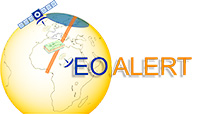PROJECT
The EO-ALERT project is an H2020 European Union research activity coordinated by Deimos Space, started in January 2018 and lasting three years, aiming at achieving very high throughput and low latency in the delivery of Earth observation images. This project has received funding from the European Union’s Horizon 2020 research and innovation programme under grant agreement No 776311. The partners of the project are Deimos Space, DLR, Technische Universität Graz, Politecnico di Torino, OHB Italia and Deimos Imaging, with the participation of the Spanish State Meteorological Agency (AEMET) as a third party. The consortium represents a balance over the full R&D cycle, from university to industry, and over the full EO value chain.

Earth observation (EO) data provided by deployed remote sensing satellites now provides a basic service to society, with great benefits to the civilian. The data generated by EO satellites is now ubiquitously used throughout society for a range of diverse applications, such as environment and resource monitoring, emergency management and civilian security; in Europe, for example, the Copernicus program provides EO data products for many of these fundamental needs, and Europe plays key roles in the global EO networks. EO data provides the basis for governmental monitoring of the Earth’s resources to support planning and management, in particular for global warming and smart cities, allows for the informed response of authorities in the case of emergencies and provides the basis for a number of commercial EO products for civil market End Users, such as precision agriculture, oil & gas, and green energy, to name just a few. As such, EO satellites, and their data products, are fundamental to modern society and are one of the cornerstones of what ESA terms “Space 4.0” , which is expected to transform the lives of citizens, decision and policymakers, and businesses in the near future.
Over the past 50 years, space and satellite industry has mastered the capability to observe the Earth for a range of applications, requiring a broad spectrum of satellite observation platforms and payloads, typically optical or radar sensors, carefully designed for the observation needs. The EO data chain that has been mastered involves, the now classical, acquisition process of sensor data onboard the satellite (flight segment, FS), its compression and storage onboard, and its transfer to ground (ground segment, GS) by a variety of communication means, for later processing on ground and the generation of the downstream EO image products. It is these EO image products that represent the real market value of the satellite EO process.
![]()
Current trends in the EO market, driven by the sharp growth in EO products applications, with a potential European EO downstream market at EUR 2.8 billion , are towards ever greater demands on the amount, type and quality of the EO products available to the End User, placing upstream demands on the satellite and its constellations, increasing the amount of data generated and transferred to ground. This is aligned with increase in image resolution.
Data latency is also a key requirement. End Users require data is available in a very short time period, with low latency – Near Real Time (NRT) – or very low latency vs enhanced-NRT, and also reliably. This has lead to the New Space “EO 2.0” actors to focus on new missions, and large constellations. Notably, what it is currently referred to as NRT consists of the provision of image products in the range of 1 to 3 hours; e.g. Sentinel-1 makes ocean products available within 1 hour of observation over NRT areas with a subscription . New Space actors call for latencies below 30 minutes, and falling.
This trend is also confirmed by the initiative “Space Data Highway for Europe” promoted by ESA and based on EDRS, whose main goal is to relay EO raw data between LEO satellites and Earth, via satellites in GEO. It enables transmission of large amounts of raw data with reduced delay, using innovative laser communication. The latency of this approach is announced to be 10-15 minutes. Although effective, this solution focuses on a complex and expensive communication infrastructure (2 or 3 GEO satellites), which precludes from a wide utilisation. Importantly, it does not pay attention to technology developments like those proposed by EO-ALERT, which will enhance the satellite onboard data handling and processing capabilities in a broad sense, to achieve comparable or better latency figures. EO-ALERT proposes a different approach.





